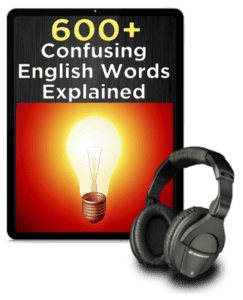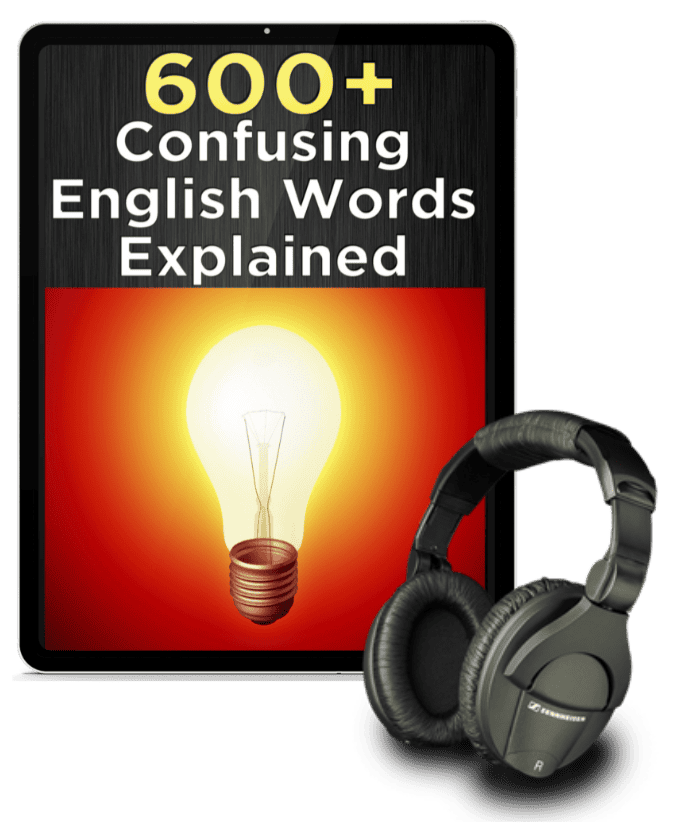
Wondering when to use lie vs. lay?
Should we say someone is “laying down” or “lying down”?
And what about lied, laid, and lain?
It can be so confusing, especially for students learning the English language!
Today we’ll learn the difference between lay and lie, as well as all forms of these two words, with plenty of examples. My goal is to make it clear for you – I hope you’ll find that it makes sense by the end of this lesson.
That’s also why I wrote an e-book called 600+ Confusing English Words Explained! It’s full of clear explanations and examples helping you understand the difference between words that lots of English learners mix up – like specially and especially, advice and advise, and many, many more.
Lay vs. Lie
Both of these words refer to the action of putting something down on a surface, or an object/person/animal resting on a surface.
However, lay has a direct object and lie does not.
A direct object is the thing that “receives” the action of the verb.
When you put a book on the table, you lay the book down. (“book” is the direct object)
But when you put your body horizontally on the bed or sofa, you lie down.
If you are putting various photos onto a table, you would be laying the photos on the table (“photos” is the direct object)
You can say that this cat is lying on the piano:

A more technical way to say it is that lay is a “transitive verb” (meaning it has a direct object) and lie is an “intransitive verb” (meaning it has no object).
Lay down or Lie down?
One reason for the confusion is that many native English speakers do say “I’m not feeling well; I need to lay down” to talk about putting one’s body in a flat position. The truth is that “I need to lie down” would be more correct, because the action is something I’m doing myself; nobody is doing it to me.
Or if they notice someone looks sick, they might ask the person “Do you want to lay down?” when again, it should be “Do you want to lie down?”
In the present, it should always be “lay something down,” as in our example when I lay the book down on the table – but informal, everyday English sometimes doesn’t follow grammar rules perfectly!

Lay vs. Lie Chart
Now that you know the basic difference between lay and lie, let’s look at their forms in different verb tenses:
| Present Tense | Present Participle | Past Tense | Past Participle |
| Lay | Laying | Laid | Laid |
| Lie | Lying | Lay | Lain |
We have LAY in the present tense, LAYING in the present participle, LAID in the past tense, and LAID in the past participle.
We have LIE in the present, LYING in the present participle (note that we spell it LYING, not LIEING), LAY in the past tense – yes! The past tense of “lie” is “lay” – and LAIN in the past participle.
Let’s look at some example sentences – first with lay. The direct object is underlined:
- I always lay the folded clothes on the bed.
(simple present tense) - We dried the towels by laying them flat in the sun.
(present participle after a preposition) - He carefully laid the baby down in the crib.
(simple past tense)

Now some examples with lie:
- My kids are tired and they want to lie down.
(simple present tense) - Your umbrella is lying over there, by the door.
(present continuous) - Last night I lay awake in bed for hours.
(simple past tense) - Unopened letters have lain on his desk for weeks.
(present perfect tense, using the past participle)

Lie: Two definitions + Examples
You might be thinking, “wait, then when do we use ‘lied’?”
It’s because the verb LIE has two meanings:
- Lie – something being on a surface
Ex) The cat is lying on the piano. - Lie – say something false, say something that is not true
Ex) He said he got a good grade, but he’s lying. He actually failed the test.
These two forms of the verb LIE have different forms in the simple past and past participle!
| Present Tense | Past Tense | Past Participle |
| Lie (something on surface) |
Lay | Lain |
| Lie (say something that isn’t true) |
Lied | Lied |
When we have lie (meaning something being on a surface, as we’ve been talking about in this lesson), then the simple past form is lay and the past participle is lain.
But when we have lie (meaning to say something that’s not true), then the simple past form is lied and the past participle is also lied.
So in the past tense, we would say:
- She got a sunburn after she lay on the beach for hours.
(rested on a surface) - David lied about his final test grade last semester.
(said something untrue)

Review of lay vs. lie:
- Lay has a direct object, lie does not. We lay the books down. We lie down on the couch.
- Informally, many people still say “lay down” for putting your body in a horizontal position, even though “lie down” is technically correct.
- The forms of the verbs are lay, laying, laid, and laid, and lie, lying, lay, and lain.
- Lie meaning not telling the truth has different forms: lie, lying, lied, and lied.
Check out my e-book on 600+ confusing words explained so you can learn lots more!
And now, to make sure you understand the difference between lay and lie and you’ll remember it, go ahead and write a couple sentences of your own using each verb. That’s your homework for today.
Learn more: Canceled or cancelled? Traveled or travelled?


